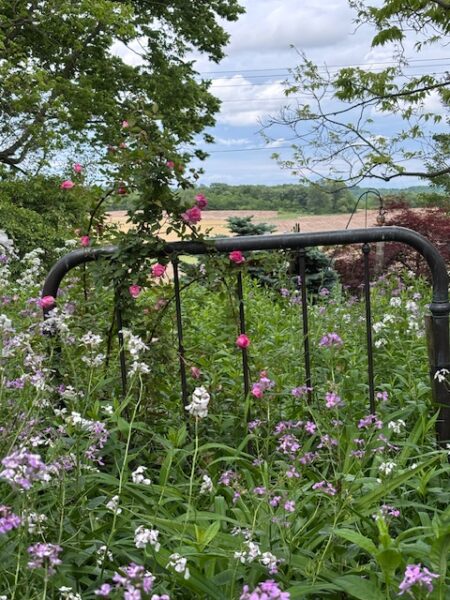Dearest monks, artists, and pilgrims,

Tomorrow is the Feast of St. Brigid, one of the most beloved saints in Ireland.
In late April I have a new book being released titled Illuminating the Way: Embracing the Wisdom of Monks and Mystics in which I explore 12 monks and mystics through the lens of archetypes, those great universal patterns we all contain within us. Brigid is featured inviting us to consider our own inner Healer. Here is an excerpt (and see below for a free mini-retreat to explore her feast day further):
Most of what we know about St. Brigid comes from the Life of Brigid written by the monk Cogitosis in the second half of the seventh century. The Life emphasizes her healings, her kinship with animals, her profound sense of hospitality and generosity, and her concern for those oppressed. These stories of the saints are not meant to be literal or historical, but spiritual, mythical, archetypal, and psychological, resonating with the deepest parts of our souls.
Her feast day is February 1 which in the Celtic calendar is also the feast of Imbolc and the very beginning of springtime. It is the time when the ewes begin to give birth and give forth their milk, and heralds the coming of longer and warmer days. She is the first sign of life after the long dark nights of winter. She breathes into the landscape so that it begins to awaken. Snowdrops, the first flowers of spring are one of her symbols.
On the eve of January 31 it is traditional to leave a piece of cloth or ribbon outside the house. It was believed that St Brigid’s spirit traveled across the land and left her curative powers in the brat Bride (Brigid’s Mantle or cloth). It was then used throughout the year as a healing from sickness and protection from harm.
Brigid’s feast day is also connected to the Christian liturgical year, followed by the Feast of the Presentation of Jesus on February 2. Spiritual writer and teacher Jan Richardson describes how this day invites us to “remember Mary and Joseph’s visit to the Temple to present their child Jesus on the fortieth day following his birth, as Jewish law required, and for Mary to undergo the postpartum rites of cleansing. Luke’s Gospel tells us that the prophets Anna and Simeon immediately recognize and welcome Jesus. Taking the child into his arms, Simeon turns his voice toward God and offers praise for the ‘light for revelation’ that has come into the world.”
Jan goes on to write that inspired by Simeon’s words, “some churches began to mark the day with a celebration of light: the Candle Mass, during which priests would bless the candles to be used in the year to come. Coinciding with the turn toward spring and lengthening of light in the Northern Hemisphere, Candlemas offers a liturgical celebration of the renewing of light and life that comes to us in the natural world at this time of year, as well as in the story of Jesus. As we emerge from the deep of winter, the feast reminds us of the perpetual presence of Christ our Light in every season.”*
In Ireland Brigid is even called Mary of the Gaels and was said to be present as a midwife to Mary at the birth of Jesus. She crosses thresholds of time and space and these stories often break the boundaries of linearity. It is said that she was born as her mother crossed the threshold of a doorway. Women giving birth often stand on the threshold of a doorway and call out her name.
Brigid was a powerful leader and one of the founders of monasticism in Ireland. She was an abbess, healer, soul-friend, prophet, and more. Many miracles are connected to her, especially related to milk. She had a white cow who could give as much milk as needed. A small amount of her butter miraculously feeds many guests. There is a sense of lavish hospitality and generosity connected to the spirit of Brigid. Many of the stories connected to her, reflect the dignity of the ordinary tasks, especially in the home. No more divisions between what is worthy of grace and beyond the scope.
To celebrate the feast of Imbolc, which in the Celtic calendar is the very early beginnings of spring, we have a gift of a free mini-retreat which is a part of our Sacred Seasons self-study journey through the Celtic wheel of the year. Go to this link and scroll down to the heading Seasonal Themes and you will see the first retreat offered there to try for yourself. Reflections by John Valters Paintner and myself, invitations to meditation and creative practice, a song about Brigid, and a dance led by Betsey Beckman are some of the treats waiting for you there.
I am returning to my regular contributions to the Patheos website, this time with a blog titled The Sacred Art of Living. You can read my intro article here>>
With great and growing love,
Christine
Christine Valters Paintner, PhD, REACE
Dancing monk icon of St. Brigid © Marcy Hall of Rabbit Room Arts (you can order prints from her Etsy shop).
*from Jan Richardson’s reflection Feast of the Presentation/Candlemas



